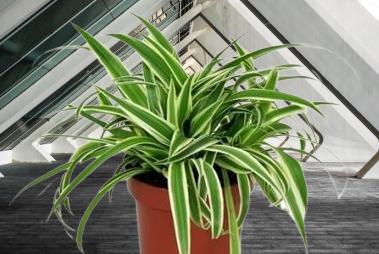To provide the plant with the nutrition and nutrients it needs, feed the chlorophytum with compound plant food once per fortnight within the spring and summer. Feeding is very necessary throughout the growing and budding periods. Fertilising isn’t suggested during the winter dormancy period. If it’s necessary, lessen any broken leaves. additionally cut back once the plant has to be shaped. If you are doing not do this, the flower can proliferate. The plant tends to adapt well to the conditions at home, however its demand for timely watering and air humidness is important. How do you take care of a Chlorophytum spider plant? Chlorophytum is very hardy and just in case of deteriorating conditions and diseases, it recovers quickly. Its attractive look additionally renders it a sexy addition to any home. it’s beautiful as a solitary plant in an exceedingly spacious room, and might even be placed next to alternative flowers. If necessary, it can stay while not water for an extended time, feeding on the wetness hold on in its succulent roots.
Chlorophytum, commonly known as spider plants, are versatile and can be grown both indoors and outdoors. They are popular choices for indoor plants due to their adaptability and low maintenance requirements. However, in suitable climates, they can also be grown outdoors as ornamental plants.
Indoor Care: When grown indoors, spider plants thrive in bright, indirect light. They can tolerate lower light conditions, but they may not produce as many offsets (baby spider plants) in low light. Keep the soil consistently moist but not waterlogged, and allow the top inch of soil to dry out between waterings. Spider plants are well-suited to typical indoor temperatures and can adapt to a range of humidity levels.
Outdoor Care: In outdoor settings, spider plants can be grown in containers or directly in the ground. They prefer partial shade to full shade, making them suitable for areas with filtered sunlight or dappled shade. Ensure well-draining soil, and water them regularly. Spider plants are generally hardy and can tolerate a range of conditions, but they may be sensitive to frost. If you live in an area with occasional frost, it’s best to bring them indoors during colder periods.
Whether indoors or outdoors, spider plants are known for their arching, variegated leaves and the production of offsets that dangle from the mother plant. They are also effective at purifying indoor air, making them popular choices for homes and offices.
Ultimately, the decision to grow Chlorophytum indoors or outdoors depends on your local climate, available space, and personal preferences. If you’re growing them outdoors, be sure to consider the specific conditions in your garden or landscape to provide the best care for your spider plants.
Are spider plants good for beginners?
The perennial tracheophyte Chlorophytum is found within the wild of African nation and Australia. Scientists are still debating regarding whether or not the chlorophytum belongs to the liliaceous plant family, the liliid monocot family or the shrub family. The genus includes more or less 250 totally different species. The unpretentious character of the chlorophytum may be a major advantage over different ampelous indoor plants, that the beginners are desperate to grow them.
How does a spider plant reproduce?

How do you propagate chlorophytum? What type of propagation is used for spider plants? How do spider plants reproduce asexually? Chlorophytum is propagated in 2 ways: by development the female offspring rosettes (‘offspring’ that are on the flower stalk) and by rending the bush by movement and replanting. The propagation procedure can be disbursed at any time of the year. For rooting, place the cuttings in water or plant them now into the loose substrate. If the roots are too weak, enable them to square in water for many days in order that they will grow a small amount and so plant them out. Dividing the woody plant and re-potting it into totally different pots if the plant is three to four years old. Water the plant well before planting, then take away it once one or two of hours and use a pointy knife to separate the foundations. lookout to avoid damaging the plant and destroying the root ball. Then remove the dried out or rotten components of the root and place the parts of the plant within the giant pots that are ready beforehand.
Does chlorophytum like the sun indoors?
Chlorophytum is best exposed to bright however subtle light, love next to a west-facing or east-facing window. Too bright sun will dry out the thereforeil and cause the leaves to lose their original wealthy colour. The shade can cause the stripes on the leaves to disappear, so it’s not judicious to push the plant too way into the room. Plants placed on a southern window ought to be shaded from direct daylight. Chlorophytum solely desires some of hours of direct sunlight daily to keep up its vitality and beauty.
Chlorophytum pot preparation Chlorophytum like neutral soil (pH 6-6.5), nutrient-dense and friable, consisting of approximately one part humus, two parts turf, two parts leafy soil and one part sand. Chlorophytum like neutral soil (pH 6-6.5), nutrient-dense and friable, consisting of roughly one half humus, 2 components turf, two parts ivied soil and one part sand . Chlorophytum tolerates each high humidness and a few dryness. Regular spraying is beneficial, particularly on hot summer days and through the central heating. Occasionally, you’ll be able to offer your plants a shower and conjointly clean the leaves. bear in mind that the leaves of the chlorophytum are quite brittle and fragile.

The perennial tracheophyte Chlorophytum is found within the wild of African nation and Australia.
The perennial tracheophyte Chlorophytum is found within the wild of African nation and Australia.